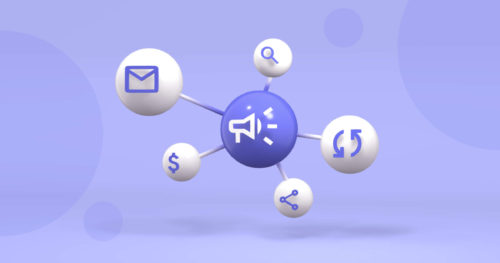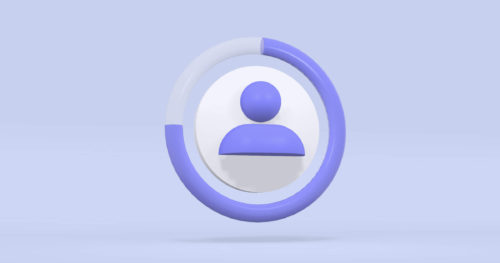Even though you might think knowing demographic data about your audience is enough, it’s not. You must also understand whether people are ready to convert by determining purchase intent. Otherwise, you risk pumping money into targeting consumers that show no genuine interest in buying your product.
Analyzing the likelihood of a consumer to purchase your product or services requires detailed information about customers that you can only collect with software. Yet, once you set up automated customer monitoring and analysis, the benefits will bring your business to a new level. You will be able to implement programmatic advertising, personalize every message, and generally grow your revenue through increased conversions.
Would you like to learn more about measuring purchase intentions and how to nurture customers? Find everything you need to know in this guide.
What is Buying Intent?
A buying intent (also purchase intent and purchase intention) is the consumer’s likelihood to buy a product or service from a specific company. Marketing and sales professionals use this metric to evaluate whether potential customers are about to convert and focus on the most promising target group. This way, they don’t waste time nurturing people who are unlikely to spend money. Instead, they narrow down the audience to personalize marketing activities and grow conversions.
4 Types of Purchase Intent Based on Funnel Stages
Since every customer lands on your online resource with a different goal in mind, a purchase intent also differs. Overall, the intentions are closely interrelated with a purchase funnel. A lead may only want to check some information or, vice versa, visit your website with readiness to convert.
So, here are the types of buying intent and the marketing funnel stages they correspond to:
1. Informational = Awareness
This intent happens when consumers gather information about a specific topic. For example, a person might want to read how to get rid of acne and, therefore, googles helpful tips. They are not interested in your product or service, but want to educate themselves or find a solution to their problem.
This buying intent type corresponds to the awareness stage of the marketing funnel. So far, merchants should only educate leads and guide them to the following steps without offering discounts or promotions.
2. Investigational = Consideration
These leads are in the research stage. They may have already decided what product or service they need but want more time to pick the best option. They explore different brands, compare products, read reviews, and check social media content for online research.
The main goal of those with investigational purchase intent is to evaluate what the market offers them. The best way to nurture such leads is by showing them relevant propositions and personalizing marketing messages.
3. Navigational = Acquisition
People showing the navigational buyer intent are interested in a specific brand. For example, when someone searches for an “official vans website,” they probably want to shop at vans.com.
Compared to the informational and investigational intents, this type is related to people with a stronger desire to buy something. You may have already acquired them as leads but still haven’t turned them into customers.
Note that despite being interested in your brand, they may still bounce and become competitors’ customers. That’s why you should nurture them with promotions and account-based marketing.
4. Transactional = Service/Loyalty
The transactional intent signal is for sure your favorite one, since it means that potential customers are about to place an order. They are the closest to the required conversion and deserve a lot of attention from the sales and marketing team. You can give these leads a personalized promotion like a 10% discount on the product added to favorites. It should help to retain customers and nudge them to convert.
After a transaction, these buyers may stay with your brand and become loyal customers. They will keep coming back directly to your store with a powerful navigational or transactional intent.
Factors that Influence a Consumer’s Likelihood to Buy Your Products
Most companies aim to gain insight into what affects the buying intent to better meet their customers’ expectations. The demand for reliable buyer intent data (we’ve talked about it in depth here) inspires researchers to study factors that make people place an order from a specific company. For example, recent research shows that social commerce constructs, trust, and online behavioral advertising have the most impact. Other studies list economy, necessity, and reliability as key factors.
Summarizing multiple sources, we can conclude that the purchase intent mostly depends on the following things:
Global economic situation. Regardless of whether you like it or not, the purchasing power depends on the welfare of your target audience. When people cannot make a living, their buying intent will be informational.
Customer value. Customer value reflects the perception of your product or service worth. When people feel they will get many benefits from the purchase, they order more willingly.
Social commerce constructs. Positive ratings, reviews, recommendations, and referrals from other users can convince potential customers to choose your brand among hundreds of other alternatives.
Brand image. Your brand’s general impression on consumers affects their readiness to purchase from you in the final marketing funnel stages.
Visual merchandising. The colors, fonts, and design of an online resource are as essential to making consumers convert as the location or shopfronts in offline stores.
These are some universal things that may strengthen or weaken a buying intent. Yet, if you want to make your business truly successful, you will need to gather buyer intent data and analyze what affects the buying process most.
How Do You Measure the Likelihood of Purchase?
Measuring buying intent is an effort-consuming process that starts with large-scale data collection. You won’t be able to record all the necessary customer info without advanced CRM and website analytics software. Although you can track some buyer signals manually, such data won’t give you the big picture.
Learn what you need to collect and how to process these findings below.
What Data to Collect for Measurement, and How?
You will have to track the overall customer activity on your website to understand what people do there and gain insight about specific users. This way, you will see general trends while being able to focus on a narrow target audience.
Individual intent signals include:
Customer behavior: individual data on clicks, scrolls, hovers, page views, on-site searches, and registrations.
Device: data generated by a mobile phone, web browser, or any other device used for browsing.
Clickstream: customer ID, time stamp, name and category of the selected product, price, total price of all products in the basket, total number of all products in the basket, session duration.
Survey: brand tracking surveys asking customers what they think about a specific brand.
Aggregate web data includes:
Consumer behavior: most popular channels, global purchase and search trends, market tendencies.
Website: traffic volume, channel sources and distribution, content consumption.
Product: changes in the popularity of specific products, general consumer preferences, and product value.
Overall, there are three ways to obtain this data: You can get purchase intent details as the first-party data, collecting it directly on your website as user activity, engagement, or purchase information. You can use second-party sources (e.g., social media and search engines) to access reports on global user interests and online trends. And you can cooperate with third-party providers to order professional research. They will implement consumer survey panels, use internet monitoring, and track users on other websites to provide you with third-party data insights.
You can either apply these three approaches separately or join them for maximum data accuracy and to collect as many details about consumers as possible.
Manual vs. Automated Monitoring
Manual research
Although manual analysis is exhausting and inefficient, you can still do it. Even without specialized software, it is possible to get some hints on what customers think to enhance your marketing strategies.
Surveys are the simplest manual approach to monitoring purchasing intent over a certain period. You can use one of the following scales:
Likert scale. A psychometric scale that asks responders to specify their level of agreement to a statement in five points, from “Definitely will recommend this product (5)” to “Will never use it (1)”.
Juster scale. An eleven-point purchase probability scale gives a very accurate view of the customer’s readiness to convert through detailed estimates.
Automated software
Professional tools like Verfacto are the easiest and the most reliable way to know how far your leads are from purchase. They minimize the manual effort, allow tracking every customer separately in real-time, and provide you with the information you would never get manually. You have a profile for every lead with all touchpoints and browsing interests. Such software also generates behavior predictions, including purchase intent, based on machine learning.
Automated solutions also integrate with your existing software to implement complex marketing strategies. You can align multiple channels and run triggered-based marketing campaigns to ensure a personalized experience for every lead and nudge them into conversion.
7 Ways to Increase Buyer Intent
Finally, it’s time to discuss what to do if the buying intent of your existing customers is not as good as expected. Reactivation is a multi-faceted process that must be integral to your marketing strategies. Here are some ideas to make consumers more likely to place an order.
1. Make Your Keywords Better Targeted
Most people with navigational intent will come from search. Hence, to ensure your content matches their expectations, you need quality search engine optimization for your store. In particular, you must audit existing keywords to check their relevance and replace them with better options if necessary. Mind that long-tail keywords like “plumbing services in LA” are always better than general words as they are more precise.
2. Send Action-Based Real-Time Messages
Make email, social media, and other communications trigger-based by using automated marketing software. When the tool detects that a customer reaches a specific point, it will initiate personalized message delivery. For example, after the user subscribes to your blog, you can automatically send them newsletters. Tailored messages will build a connection between your brand and consumers to nurture their purchase intent.
3. Create Single-User Profiles Through Integration
Integrate all tools that store data about your potential and existing customers to have everything in one place. This way, you can estimate buying intent more accurately to know how to grow it.
4. Add Exit-Intent Website Pop-Ups
Software with exit-intent technology can analyze visitors’ mouse movements to detect when they are about to leave without purchasing. When someone moves towards the back button or stays idle for too long, show them a pop-up. A message advertising new arrivals can capture the user’s attention to make them stay.
5. Offer Discounts at the Right Moment
Even though you shouldn’t overuse discounts, sometimes they can significantly increase the likelihood of a purchase. For example, you can provide a discount on the first order. If you use special offers correctly, you will convert more visitors and sell more goods.
6. Create a Sense of Urgency
Tell customers you have X items left if the stock is low or the sale ends in 48 hours. Such messages will make them complete emotional purchases and can considerably speed up conversions. Yet mind that you must be honest with buyers and indicate real numbers.
7. Ensure a Positive Brand Image Through Reviews
Ask those who have already placed orders to share their experience. These reviews will make your brand reliable in the eyes of consumers that only get acquainted with your company. After reading positive reviews, they will be more likely to consider your products as the top option and purchase. Reviews are also an excellent way to boost lead generation.
Conclusion
Purchase intent analysis is something every ecommerce business should do to build effective marketing strategies. An optimum approach is to monitor customers non-stop with software since their behavior and preferences regularly change. Once you have real-time data, you can run personalized marketing campaigns to increase sales and nurture consumers’ willingness to buy.
FAQs
How do you determine buying intentions?
You can ask customers through surveys with questions like “How likely are you to recommend us to your friend” and use web analytics software. Web tools will subtly gather behavioral and device data to detect leads that are actively seeking to purchase.
Many modern solutions like Verfacto provide ready information on purchase intent, completing all the analysis for you.



